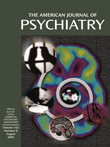To the Editor: Antipsychotics are thought to influence the subjective well-being of patients, depending on the occupancy of these receptors
(1–
3). Drug-induced dysphoria is related to quality of life and medication compliance. It may also be a sensitive marker for too high dopamine D
2 receptor occupancy caused by conventional and newer-generation antipsychotics
(1–
3). However, adverse mental effects of antipsychotics are difficult to differentiate from primarily negative symptoms and depressive symptoms, and little is known about which aspects of subjective experience are most strongly related to D
2 receptor occupancy.
We sought to identify which aspects of subjective well-being are most strongly related to D2 receptor occupancy by conventional and newer-generation antipsychotics.
An analysis was performed on the combined data of two previous studies
(2,
3). These studies were approved by the ethics committee of the Academic Medical Centre, Amsterdam, the Netherlands. The subjects, 50 patients, 48 with recent-onset schizophrenia and two with schizoaffective disorder, were diagnosed according to DSM-IV criteria; 45 were men, and the mean age was 22.1 years (SD=2.5).
The patients’ subjective experience was measured with the Subjective Well-Being Under Neuroleptics Scale
(4) after a stable dosing period of at least 6 weeks of olanzapine (N=27, mean=11.2 mg/day, SD=4.5), risperidone (N=12, mean=3.6 mg/day, SD=1.1), or haloperidol (N=11, 2.5 mg/day). Higher scores on the Subjective Well-Being Under Neuroleptics Scale imply more favorable subjective well-being. To determine the levels of striatal D
2 receptor occupancy, [
123I]IBZM single photon emission computed tomography imaging was performed. Specifications of comparison group, imaging procedures, and data analyses have been described elsewhere
(1,
2).
All 38 items from the Subjective Well-Being Under Neuroleptics Scale were negatively correlated with D2 receptor occupancy, with 28 items reaching statistical significance (Spearman’s correlation, two-tailed). The highest correlations were found for five items on the Subjective Well-Being Under Neuroleptics Scale that could be described as “feeling comfortable, self-confident, and safe”: “I feel very comfortable with my body” (rs=–0.448, df=49, p=0.001), “My body is a burden to me” (rs=–0.433, df=49, p=0.002), “I am full of confidence, everything will be all right” (rs=–0.429, df=49, p=0.002), “I do what I want to do and know how to assert myself” (rs=–0.419, df=49, p=0.002), and “I feel safe and secure” (rs=–0.382, df=49, p=0.006).
Negative subjective experiences are related to D2 receptor occupancy by conventional and newer generation antipsychotics. Monitoring feelings of comfort, self-confidence, and safety may guide clinicians and researchers to find optimal D2 receptor occupancy. To test this hypothesis, however, more research is needed.

